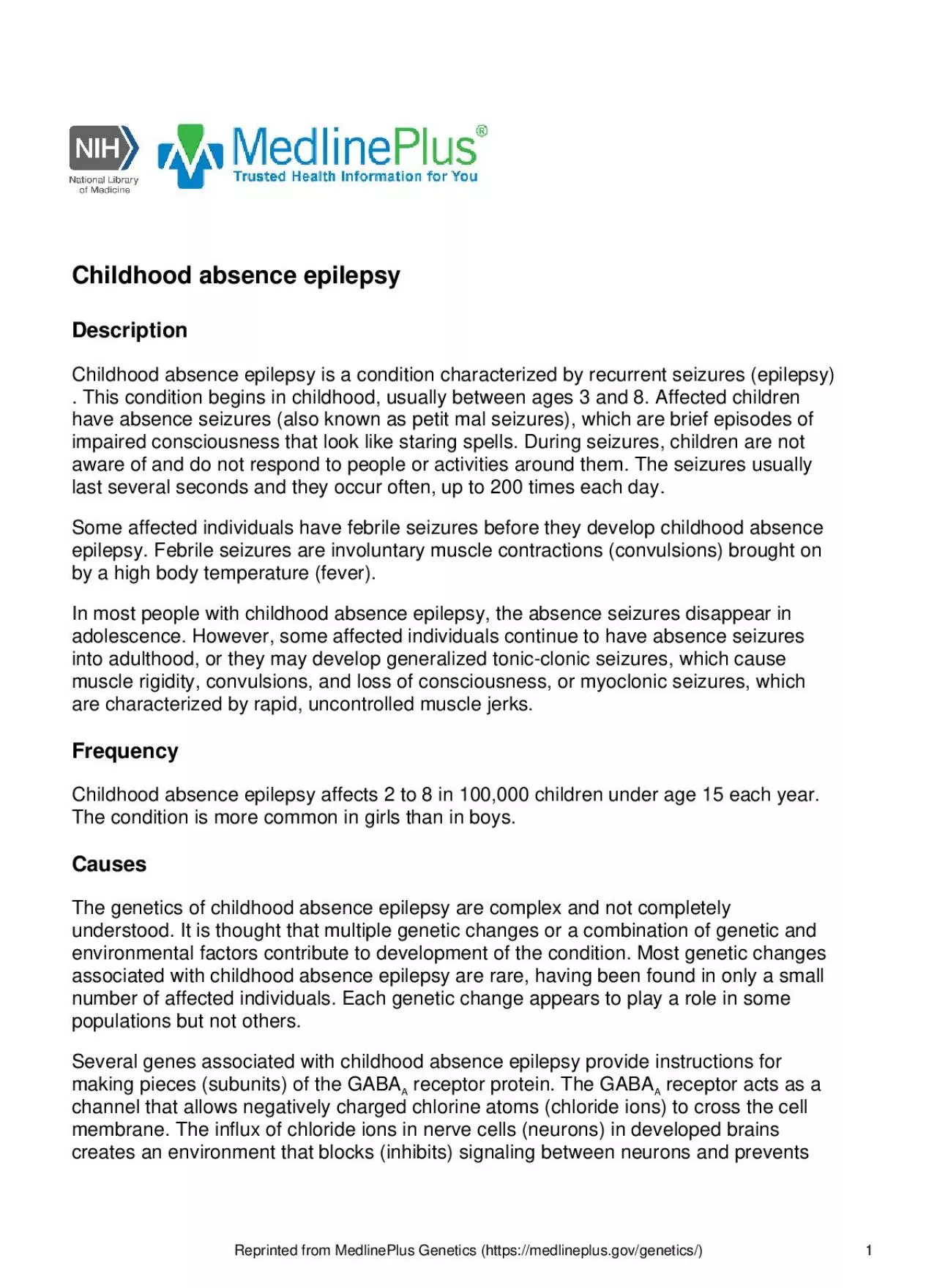

1 Childhood absence epilepsy Description epilepsyepilepsy This condition begins in childhood usually between ages 3 and 8 Affected children also known as petit mal seizuresalso known as petit mal ID: 953420
Download Pdf The PPT/PDF document "httpsmedlineplusgovgeneticshttpsmedlinep..." is the property of its rightful owner. Permission is granted to download and print the materials on this web site for personal, non-commercial use only, and to display it on your personal computer provided you do not modify the materials and that you retain all copyright notices contained in the materials. By downloading content from our website, you accept the terms of this agreement.
https://medlineplus.gov/genetics/https://medlineplus.gov/genetics/ 1 Childhood absence epilepsy Description epilepsyepilepsy . This condition begins in childhood, usually between ages 3 and 8. Affected children also known as petit mal seizuresalso known as petit mal seizures impaired consciousness that look like staring spells. During seizures, children are not aware of and do not respond to people or activities around them. The seizures usually last several seconds and they occur often, up to 200 times each day. Some affected individuals have febrile seizures before they develop childhood absence convulsionsconvulsions feverfever In most people with childhood absence epilepsy, the absence seizures disappear in adolescence. However, some affected individuals continue to have absence seizures into adulthood, or they may develop generalized tonic-clonic seizures, which cause muscle rigidity, convulsions, and loss of consciousness, or myoclonic seizures, which are characterized by rapid, uncontrolled muscle jerks. Frequency Childhood absence epilepsy affects 2 to 8 in 100,000 children under age 15 each year. The condition is more common in girls than in boys. Causes The genetics of childhood absence epilepsy are complex and not completely understood. It is thought that multiple genetic changes or a combination of genetic and environmental factors contribute to development of the condition. Most genetic changes associated with childhood absence epilepsy are rare, having been found in only a small number of affected individuals. Each genetic change appears to play a role in some populations but not others. Several genes associate
d with childhood absence epilepsy provide instructions for subunitssubunits A receptor protein. The GABA A receptor acts as a chloride ionschloride ions neuronsneurons inhibitsinhibits https://medlineplus.gov/genetics/https://medlineplus.gov/genetics/ 2 the brain from being overloaded with too many signals. Mutations in GABA A receptor subunit genes lead to production of altered subunit proteins that cannot form functional receptors, so fewer GABA A receptors are available. As a result, neurons become overloaded with signals. Researchers believe that the overstimulation of certain neurons in the brain triggers the abnormal brain activity associated with seizures. Problems with another type of ion channel, called a calcium channel, are also associated with childhood absence epilepsy. Calcium channels transport positively calcium ionscalcium ions release of neurotransmitters, which are chemicals that relay signals from one neuron to another. Mutations that result in overactive calcium channels cause certain neurons to become overstimulated, triggering seizures. Mutations in other genes that do not provide instructions for making ion channels have also been associated with childhood absence epilepsy. It is not clear how these changes are involved in the development of absence seizures. Learn more about the gene associated with Childhood absence epilepsy GABRA1 Additional Information from NCBI Gene: CACNA1H GABRB3 GABRG2 JRK Inheritance Because childhood absence epilepsy appears to be a complex disease without a single genetic cause, it does not have a straightforward pattern of inheritance. When a
ssociated with mutations in GABA A receptor or calcium channel genes, it seems to follow an autosomal dominant inheritance pattern, which means one copy of the altered gene in each cell is sufficient to increase the likelihood of the disorder. Some people who have the altered gene never develop the condition, a situation known as reduced penetrance. Other Names for This Condition Absence epilepsy, childhood Petit mal epilepsy Pykno-epilepsy Pyknolepsy https://medlineplus.gov/genetics/https://medlineplus.gov/genetics/ 3 A dditional Information & Resources Genetic Testing Information Genetic Testing Registry: Epilepsy, childhood absence 1 (https://www.ncbi.nlm.nih. gov/gtr/conditions/C1838604/) Genetic Testing Registry: Epilepsy, childhood absence 2 (https://www.ncbi.nlm.nih. gov/gtr/conditions/C1843244/) Genetic Testing Registry: Epilepsy, childhood absence 4 (https://www.ncbi.nlm.nih. gov/gtr/conditions/C1970160/) Genetic Testing Registry: Epilepsy, childhood absence 5 (https://www.ncbi.nlm.nih. gov/gtr/conditions/C2677087/) Genetic Testing Registry: Epilepsy, childhood absence 6 (https://www.ncbi.nlm.nih. gov/gtr/conditions/C2749872/) Genetic Testing Registry: Epilepsy, childhood absence, JRK related (https://www.nc bi.nlm.nih.gov/gtr/conditions/CN240376/) Patient Support and Advocacy Resources Disease InfoSearch https://www.diseaseinfosearch.org/https://www.diseaseinfosearch.org/ NORDNORD https://rarediseases.org/https://rarediseases.org/ Research Studies from ClinicalTrials.gov ClinicalTrials.gov (https://clinicaltrials.gov/ct2/results?cond=%22childhood+absence +epilepsy%2
2) Catalog of Genes and Diseases from OMIM EPILEPSY, CHILDHOOD ABSENCE, SUSCEPTIBILITY TO, 1 (https://omim.org/en try/600131) EPILEPSY, CHILDHOOD ABSENCE, SUSCEPTIBILITY TO, 5 (https://omim.org/en try/612269) EPILEPSY, CHILDHOOD ABSENCE, SUSCEPTIBILITY TO, 6 (https://omim.org/en try/611942) FEBRILE SEIZURES, FAMILIAL, 8 https://omim.org/entry/607681https://omim.org/entry/607681 Scientific Articles on PubMed PubMed (https://pubmed.ncbi.nlm.nih.gov/?term=%28Epilepsy,+Absence%5BMAJ R%5D%29+AND+%28childhood+absence+epilepsy%5BTIAB%5D%29+AND+englis h%5Bla%5D+AND+human%5Bmh%5D+AND+%22last+1440+days%22%5Bdp%5D https://medlineplus.gov/genetics/https://medlineplus.gov/genetics/ 4 ) References Crunelli V, Leresche N. Childhood absence epilepsy: genes, channels, neuronsand 55 Citation on PubMed (ht tps://pubmed.ncbi.nlm.nih.gov/11988776) Aidiopathicidiopathic Brain Res. 2014;213:55-85. doi: 10.1016/B978-0-444-63326-2.00003-X. Review. Citation on PubMed https://pubmed.ncbi.nlm.nih.gov/25194483https://pubmed.ncbi.nlm.nih.gov/25194483 Kang JQ, Macdonald RL. Molecular Pathogenic Basis for GABRG2 MutationsAssociated With a Spectrum of Epilepsy Syndromes, From Generalized 88 10.1001/jamaneurol.2016.0449. Review. Citation on PubMed (https://pubmed.ncbi.nl m.nih.gov/27367160) or Free article on PubMed Central (https://www.ncbi.nlm.nih.g ov/pmc/articles/PMC5426359/) Yalç õ n O. Genes and molecular mechanisms involved in the epileptogenesis 22 seizure.2011.12.002. Epub 2011 Dec 27. Review. Citation on PubMed (https://pubm ed.ncbi.nlm.nih.gov/22206818) Last updated August 1, 201